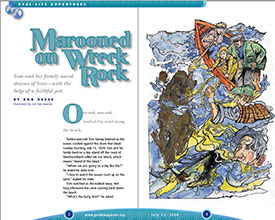Twelve-year-old Tom Harvey listened as the waves crashed against the shore that bleak Sunday morning, July 13, 1828. Tom and his family lived on a tiny island off the coast of Newfoundland called Isle aux Morts, which means “Island of the Dead.”
“Where are you going on a day like this?” he asked his sister Ann.
“I love to watch the waves crash up on the sand,” replied his sister.
Tom watched as she walked away. Not long afterward she came running back down the beach.
“What’s the hurry, Ann?” he asked.
“Where’s Father?” she gasped.
“He’s inside with Mother,” Tom replied, wondering what was wrong with his sister. He didn’t have long to wonder, because moments later Ann and their father burst through the doorway of their house.
“Come along, Tom!” called his father as they ran toward the beach. Tom followed, really curious now. He had never seen his 56-year-old father run this fast.
Ssseeet, ssseeet! whistled his father. “Come, Hairyman! Come!” Hairyman was the family dog, a large, black Newfoundland.
“Rrrffff! Rrrffff!” barked their dog as he joined the three on their race toward the beach.
“Quick, children, into the boat!” directed Mr. Harvey.
Tom could control his curiosity no longer. “Father, where are we going? And why?” he puffed as he and his sister stepped off the wharf into the family’s 12-foot fishing boat, which was rising and falling with the ocean waves.
“We’re on a rescue mission, Tom,” shouted his father above the roar of the waves. “And we haven’t a moment to lose.”
His father stepped into the rear of the boat, and Hairyman jumped into the bow. After Tom and his sister untied the boat from the wharf, the boy and his father rowed the boat straight into the waves and out to sea.
Seeing her younger brother’s questioning look, Ann filled Tom in on the details. “I had gone only a short way down the beach when I noticed a wooden barrel and a mattress floating toward shore.”
Tom needed no more explanation. These items floating in the water could mean only one thing. Somewhere offshore a ship had sunk. And the four of them were now on a rescue mission in choppy water they wouldn’t normally take their boat into.
“Let’s row along the beach so we can see if any survivors made it ashore,” Tom’s father instructed. Suddenly they spotted something on the sand. Drawing closer, they saw six men who had survived the wreck and made it to shore.
“Thank God you’re all safe,” said Mr. Harvey as they landed their punt. “How many were on board? Do you think there are other survivors?”
“Who can tell?” moaned one of the men. “We did notice a small island off to our right as we swam to shore. Perhaps others are there.”
Tom’s family knew the island well. Situated three miles from shore, it had been named Wreck Rock for obvious reasons.
As they set off for Wreck Rock, Tom could hear his father above the sound of the crashing waves: “God, if there are any more survivors, please help us find them.”
Finally Tom could see the tiny island, no bigger than most houses. Straining his eyes, he saw that nearly 200 people—men, women, and children—were stranded there. All were waving their hands wildly at the family in the tiny boat.
The closest the Harveys could get to the island was about 100 feet because the wind and waves kept pushing them backward toward their home.
Finally his father called out, “Tom, hand me that chunk of wood in the back of the boat.”
Tom wasn’t sure what his father would need a chunk of wood for, but he handed it to him. As Tom and his sister kept trying to row the boat forward just to keep it from floating backward, their father heaved the small log toward the tiny isle.
The men on shore tied a piece of rope to the wood. A man then tried swimming toward the boat while holding onto the wood. Others behind him held onto the end of the rope.
Tom petted Hairyman, who was sitting by him in the boat. “Boy, you’d like to help, wouldn’t you?”
Just then Mr. Harvey called, “Go fetch the stick, Hairyman! Go fetch the stick!”
Tom was amazed to see their dog plunge into the choppy water and dog-paddle toward the man holding the wood. Hairyman grabbed the wood while the man held onto the rope. The dog then swam back toward the bobbing boat.
“Tom, keep rowing while Ann and I pull this man in,” urged his father.
Tom strained at the oars to keep the craft steady while his father and his 17-year-old sister pulled the wet man into the boat.
“It worked!” The man sounded excited. Then he lay down exhausted.
Tom’s father threw the log back toward the island. The men ashore pulled the log in for the next rescue effort. Hairyman kept watching the large chunk of wood.
“Go get it!” called Tom. “Go fetch the stick.”
This time a woman picked up the two-foot log and made her way into the water. Right away Hairyman grabbed the log and towed her to the boat, while she held the rope.
Again and again this procedure was repeated for the rest of that day, the next day, and the day after that. During that time Tom, Ann, their father, and the dog were able to rescue 163 people. They turned out to be immigrants from Ireland who were moving to Canada.
But Tom and his family weren’t finished helping the survivors yet.
Because there wasn’t enough housing on Isle aux Morts, the Harveys helped some of the men build large lean-tos.
Food was another scarcity. Though there were eight children in Tom’s family, his parents shared all they had with the Irish immigrants. Tom didn’t know what they would do when the food ran out, but he knew enough to trust in God.
Fortunately the HMS Tyne arrived eight days later to transport the survivors onward to Halifax, Nova Scotia. Once Captain Grant of the rescue ship found out there were no provisions left on the island for the Harveys and the other inhabitants, he ordered that the people’s bread and flour supplies be replenished from the provisions on board his ship. Tom could certainly see the Lord’s leading there.
And sometime later Lloyd’s of London gave the Harveys a check for 100 pounds for their selfless heroism!


